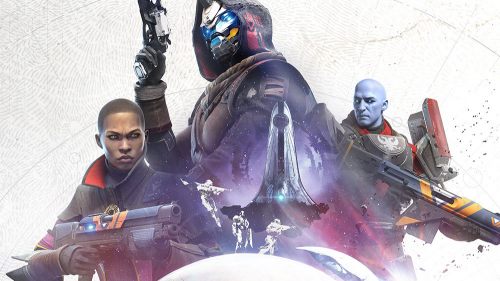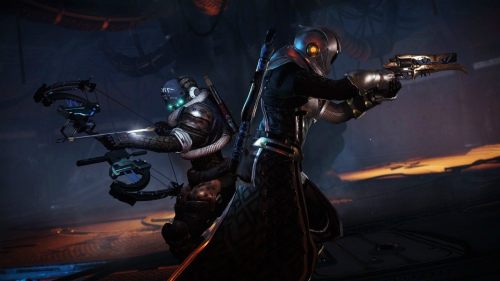DESTINY 2: SHADOWKEEP Game Review: DESTINY Finds Its Destiny
Destiny always occupied a bit of a weird place in the video gaming landscape. It was a first-person shooter, but also a sort-of MMO. It was a full-priced game, but with a similar cosmetics microtransaction market to what you’d find in a free-to-play game. It was intended as an ongoing saga, yet felt held back by a schedule of irregular content dumps that made continued play a grind. It was a Bungie game, but published by Activision.
Nearly all of that changes with Destiny 2’s second major expansion, Shadowkeep. It represents a significant change in philosophy from Bungie, enabled in part by the company’s separation from Activision earlier this year and the subsequent learnings that came next. Bungie’s new vision is of an action-RPG set in a single evolving world, playable anywhere with anyone, and this year’s changes made to Destiny 2 clearly reflect those design pillars. It’s now free-to-play (except for certain bits of content); updates and story evolutions are more frequent; and the game now feels much more like the MMO it always danced around being - without sacrificing its roots as a typically excellent Bungie first-person shooter.
Shadowkeep’s story takes players back to the Moon, one of the first game’s most popular locations, and it progresses the franchise’s main storyline more significantly than nearly any of its campaigns thus far. The Destiny universe’s mysterious Big Bads have finally reared their (meta)physical heads, and the game deploys that story through some truly stunning level-design reveals. Whether those reveals are spine-tingling or head-scratching will depend on your familiarity with the franchise, but this veteran player was left dumbstruck at least once. Between the nostalgia of returning to the newly-dilapidated Moon, and the anticipation of what’s to come, it’s an exciting time to be a Guardian.
It’s also a scary time to be a Guardian, and not just because the aforementioned Big Bads are on their way (or, arguably, have been here all along). Where Forsaken shifted the game’s aesthetic to high fantasy, setting much of its action in essentially an elven kingdom in space, Shadowkeep goes full-on dark fantasy, introducing “nightmare” versions of notorious enemies that function as manifestations of traumas past. Design-wise, everything’s very dark, very red, and very gnarled: the architecture is grand and spiky, with eerie crimson phantoms scattered around it, suspended in silence or crying in agony. Space goth Eris Morn plays a typically foreboding guide, surrounded by the literal ghosts of her former fireteam. It’s as metal as Destiny has ever been - even more so than the literally metal-themed Rise of Iron.
As far as gameplay additions goes, Shadowkeep doesn’t deliver anything quite so significant as the first game’s Taken King expansion, or the second game’s Forsaken. Aside from the new campaign and patrol zone, the new activities are limited to Nightmare Hunts, essentially modified replayable campaign missions, and the new 6-player matchmade Vex Offensive activity. The Vex Offensive is repetitive, but rewarding: it’s a pretty standard Destiny wave/objective mode, but features some nifty mechanics and level design, and it’s got a specific story purpose too. Even the new, lunar additions to basic open-world elements like Patrols or Lost Sectors have been given extra narrative weight and structure, telling a Doom-esque tale of Guardians past encountering an unspeakable horror.
The endgame goal of Destiny 2 - the reason players keep doing raids and other endgame activities over and over - is to improve your character’s gear, and here Shadowkeep has made small, but welcome changes. While weapons function much as before, armour has been completely revamped, with considerably more customisability and more paths to pursue with upgrades. The new Seasonal Artifact allows players to unlock powerful mods as they play through the season, and it’s just one part of the new interlocking web of gear management. Disappointingly, there’s not much new gear per se, apart from some typically unique Exotic weapons, but the stat-heavy “Armour 2.0” system affords players the ability to craft character builds specifically attuned to certain activities, which begs the question of why Destiny 2 still lacks an in-game loadout system.
Destiny 2 is a game of grind, and as ever, much of Year 3 will be made up of playing “ritual” activities - strikes, Crucible, Gambit - to fulfill bounties or quest steps, gain XP, and get new loot. Though the grind grows unrewarding after hitting the new power-level cap, the high-level activities have been spiced up a bit, with new strikes, multiplayer maps, and difficulty options. Competitive multiplayer now features a solo-specific playlist, preventing premade teams from mopping the floor with teams of scattered individuals, and Nightfall strikes have been ramped up in difficulty and granted matchmaking on the lower difficulty levels. A little accessibility goes a long way.
Controversially, Shadowkeep introduces a Season Pass mechanic, similar to those found in games like Fortnite, deploying regular rewards for XP gained - and significantly more rewards for those who pay for the pass. Destiny's way of doing this is less intrusive than Fortnite, though, granting rewards that would eventually drop from play anyway - duller than Fortnite’s aggressively advertised cosmetic items, but that’s probably more appropriate for Destiny’s on-average older players who aren’t going to get bullied at school for not having the latest Fortnite skin. The battle pass also includes a number of extra activities and exotic quests, and for the amount Destiny players play Destiny, it’s a decent deal. Only the Eververse cosmetic store feels like price-gouging, but I’ve never felt like I need to open that UI tab anyway.
Perhaps the best change in Shadowkeep - only really visible now, a couple weeks into the season - is Bungie’s commitment to a constant stream of story and gameplay developments. Since launch, new activities and locations have opened up, characters have refreshed their dialogue, and it really feels as though there’s an ongoing story taking place. That’s partially due to Bungie’s newfound freedom to deploy updates in a more agile fashion, but it’s equally down to Herculean feats of management to keep developers, designers, artists, and writers synchronised to a rolling schedule. It’s exciting to log in after each weekly reset to see what’s changed, which hasn’t really ever been the case before. With new quests appearing regularly, it seems unlikely Destiny players will run out of things to do anytime soon.
For new players, all of this is bound to be a bit bewildering. Bungie has revamped the introductory mission from the first Destiny for inclusion in the free-to-play “New Light” version of the game, but after that, players are dropped into a vast sea of options, with a surprisingly generous swathe of content available without paying a cent. If you’re unfamiliar with the game’s lore, the sheer volume of characters, storylines, and activities is going to be overwhelming. Bungie would do well to offer a clearly-marked suggested path of play to make sense of it all.
If you get heavily into Destiny 2, as I have, you’ll be rewarded with an epic, strange, often absurd narrative; a terrific player community; and some of the best-designed levels and gunplay in the business. I love this stupid, brilliant, goofy space-wizard game with all my blackened little heart, and I’ve internalised its themes and lore as much as I have the interactions I’ve enjoyed on it. Hopefully the risks Bungie has taken pay off, because this game has been important to me in deeply personal ways - but that's another essay. Maybe it'll work for you too. Bring some friends - after all, the vast majority of the game is now free.



